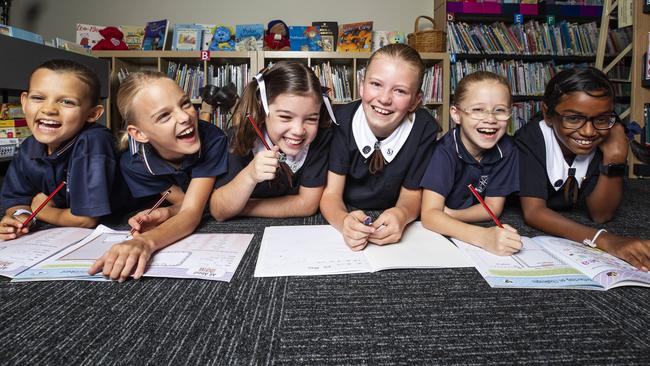Girls, students with language background other than English succeed in NAPLAN
Queensland’s NAPLAN results reveal not only a gender divide, but a divide between country and city. SEE WHO’S WINNING
Schools Hub
Don't miss out on the headlines from Schools Hub. Followed categories will be added to My News.
GIRLS are dominating NAPLAN in every subject and year level, while Queensland is still gripped by a city and country divide, a new NAPLAN report reveals.
Girls have outperformed their male counterparts in all five testing areas (reading, writing, spelling, grammar and punctuation, and numeracy) in each year level (3, 5, 7 and 9) when comparing the percentage of students at or above the national minimum standard (NMS).
2019 NAPLAN results: Queensland slides backwards in tests
Kylie Lang: Whether it’s OP or ATAR, the pressure around a final number is ridiculous
Qld OP results 2019: How public and private schools compared
St Margaret’s Anglican Girls’ School said the schools emergence as the top primary school with “strong results” reflected the quality of teaching and learning opportunities at the school.
“We have a long-term commitment to specific programs across all year levels in the primary school, right from Prep, that contribute to our students ongoing numeracy and literacy growth,” she said.
The report also revealed that Queensland students with a language background other than English (LBOTE) are outperforming students with English speaking backgrounds in spelling across year three year levels and matched writing scores in year 7.
Higher percentages of LBOTE students achieved the NMS compared with their non-LBOTE peers in year 3 (93.2 compared with 93), year 7 (94.2 compared with 93.8) and year 9 (93.3 compared with 92.7).
Major cities still record the most students at or above the NMS in all five testing categories with fewer students achieving the benchmark in inner and outer regional areas, followed by remote and very remote schools.
The best of results outside major cities was inner regional schools for year 3 writing at 95.6 per cent of students at or above NMS. Followed by Year 3 writing in outer regional at 95.6, then inner regional reading scores with 95.5 per cent of students at or above NMS.

Grattan Institute school education program director Peter Goss said overall cumulative gains showed there had been significant improvements in NAPLAN for many groups of students, including significant gains for Indigenous students. However, he said the national minimum standard was setting the bar too low.
“It’s fantastic we’re giving Australian girls better education opportunities than we used too,” he said.
“Australia is a rare country in the world in that immigrant kids often do better than kids born in Australia speaking English at home, some of that seems to be desire to do well in education and cultures that value education very strongly,” Dr Goss said.
Australian Curriculum, Assessment and Reporting Authority chief executive David de Carvalho said since testing began in 2008 there have been significant gains in a number of testing areas and year levels.
The 2019 NAPLAN national report confirms the findings of the school-based summary results released in August last year, which showed Queensland had lower scores in 2019 for 12 out of 20 categories compared with 2018 results.
But overall there was key success around the state, with Year 3 Grammar and Punctuation, Year 5 numeracy and Year 7 numeracy and reading scores improving.
Writing improved on average compared with the previous year but year 5,7 and 9 results remained lower than the subjects base year in 2011.
MORE NAPLAN RESULTS:
Decade of NAPLAN tests show how our schools have changed
Parents urged not to pull kids from NAPLAN tests


